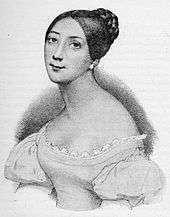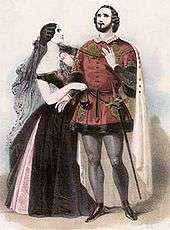Giovanni Matteo Mario
Giovanni Matteo De Candia, also known as Mario (17 October 1810 – 11 December 1883), was an Italian opera singer. The most celebrated tenor of his era, he was lionized by audiences in Paris and London. He was the mate of the opera singer Giulia Grisi.
Early life
Mario was born in Cagliari, Sardinia on 17 October 1810 as Giovanni Matteo De Candia; his inherited heraldic titles were Cavaliere (Knight), Nobile (Nobleman) and Don (Sir) in the Kingdom of Sardinia and subsequently the Kingdom of Italy.[1]
His aristocratic family belonged to the Savoyard-Sardinian nobility and social elite, part of the Kingdom of Sardinia ruled by the House of Savoy.[2] His relatives were members of the Royal Court of Turin, while his father held the rank of general and was aide-de-camp to King Charles Felix of Sardinia (house of Savoy).[3]
In order to free himself from the burdensome ancestral traditions which he had inherited, and to mitigate his father's opposition to a member of the high-born De Candia family pursuing a 'lowly' musical career, the budding singer adopted the one-word stage name of "Mario" when he made his debut on 30 November 1838.[3] Sometimes, however, he is referred to in print by the fuller appellation of "Giovanni Mario" and he is also called "Mario de Candia".
Mario's decision to become a professional singer arose from accidental circumstances. He was 12 years old when he moved from Cagliari to Turin, where he studied at the Royal Military Academy. Among his fellow students at the academy was the future Prime Minister of Italy, Camillo Cavour. While serving as a second-lieutenant in the King of Sardinia's Guards in Turin, he got some debt. His father refused to help him and the young man, on 24 November 1836, was expelled from the army.[4] Then he left Piedmont and travelled to Paris. The fugitive nobleman was made to feel welcome in Parisian salons and in the city radical milieu, especially in the salon of principessa Cristina Belgiojoso, where he was appreciated as an amateur tenor.[5] For a time he earned his living by giving fencing and riding lessons. People believed him to be a count or a marquis and he never made clear to be only "cavaliere".
Operatic career, liaison with Grisi and death


Because he possessed an exceptionally fine natural voice, Mario was encouraged by the composer Giacomo Meyerbeer to become a singer. He took singing lessons from two teachers, a Frenchman named Ponchard and the former Italian tenor Marco Bordogni, and proved so gifted that he was swiftly offered an engagement with the Opéra. The young tenor made his debut there on 30 November 1838 as the hero of Meyerbeer's Robert le diable.[3] Meyerbeer had provided a new recitative and aria for him in the second act (the "Mario-Aria"). Mario's performance generated great excitement, and "a new star was born".[6]
Despite scoring an immediate success, owing to the splendid quality of his singing and a dashing stage presence, he did not choose to stay long at the Paris Opéra. In 1839 he was first heard in London, achieving instant success in Donizetti's Lucrezia Borgia, where he met the famous Italian soprano Giulia Grisi. Then he joined the Théâtre Italien, where such illustrious singers as Maria Malibran, Henriette Sontag, Fanny Tacchinardi Persiani, Giulia Grisi, Giovanni Battista Rubini, Antonio Tamburini, and Luigi Lablache regularly performed. His first appearance there was as Nemorino in Donizetti's L'elisir d'amore.[7]
From 1841 Mario and Grisi lived together. The acclaim that Mario received in Italian opera surpassed even that which he had won in French opera, and he soon acquired a Europe-wide reputation for the beauty of his singing and the elegance of his bearing. He possessed a handsome face and a lithe figure (he liked to show off his legs in tights), and his lyrical voice, though less dazzling than that of the older, virtuoso tenor Giovanni Battista Rubini nor so powerful as that of his younger rival Enrico Tamberlik, was described as having a gracefulness and a beguiling, velvety softness that made it unique. The music critic and playwright George Bernard Shaw, who was born in 1856 and therefore could not have heard Mario in his prime, said his singing featured a marked vibrato.
Mario created few operatic parts, the most notable being that of Ernesto in Donizetti's Don Pasquale (1843). However, he sang in the première of Rossini's Stabat Mater and Verdi wrote a new cabaletta for him to sing in the main tenor aria in I due Foscari for a production in Paris. In established roles, Mario's very greatest performances were as the title character in Rossini's Otello of the same name, Gennaro in Lucrezia Borgia, Almaviva in Il Barbiere di Siviglia, Fernando in La favorite, the Duke in Rigoletto, Alfredo in La traviata, Manrico in Il trovatore, Lionel in Martha and many others. The Royal Opera House, Covent Garden in London and the Théâtre Italien in Paris were the scenes of most of his stage triumphs. He sang in London from 1847 until 1867 and again during 1871.
Mario also made occasional appearances elsewhere in England in oratorio, for example at the Birmingham Festival of 1849 and at the Hereford Festival of 1855. Also, he undertook a string of concert tours around the United Kingdom. In about 1849 he acquired the "Villa Salviati" in Florence. At his salon there he received many distinguished cultural figures and members of the European nobility.
In 1854 he toured America with Giulia Grisi, earning much money and much adulation during their trans-Atlantic jaunt. Mario could never marry Grisi, because she was married although separated, from Gérard de Melcy and divorce was not permitted. Before meeting Mario, Grisi had also had a son, whose father was Lord Frederick Castlereagh, a nephew of the famous Robert Castlereagh. The child was acknowledged by Castlereagh with the name Frederick Ormsby. Mario and Grisi had six daughters. One of these was Cecilia Maria De Candia, who married an Englishman, Sir Godfrey Roberts Pearse, and left an account of her parents' careers.[8]
During a trip to Saint Petersburg in 1869 Mario's loving wife Giulia Grisi died in Berlin, after which he went on to sing at the St. Petersburg theatre. During this time his daughters were put under the care of tutors assigned by their godmother, the Grand Duchess Maria Nikolaievna, Duchess of Leuchtenberg and president of the Imperial Academy of Arts in St. Petersburg.
Mario bade farewell to the stage at Covent Garden in 1871, but his last performances were concerts in a USA tour with Carlotta Patti in 1872-73.
He spent his last years in Rome, where he was a friend of Prince Odescalchi, but he was in some financial difficulties which now beset him owing to his habitual extravagance. It is said that he used to smoke cigars continually,[9] even when taking a bath.
A benefit concert was mounted for Mario in London in 1878 and collections reached £4,000,[10] that provided a pension for the old singer. He died in Rome in 1883 and was buried in his town Cagliari in 1884.
The De Candia ancestral seat
In 1847 Mario bought a house in Sardinia for his mother where she and his brother Carlo lived. It is situated in Cagliari Old Town (Castello), in Contrada S. Caterina 1 (now via Canelles).[11] This house is now a part of a nuns' convent. His brother Carlo's family lived in another house in the vicinity, located at the bottom of Via dei Genovesi, where until the 16th century stood the Pisan town-walls between the Elephant and the Lion Towers. The façade was possibly designed in the neoclassical style by the architect Gaetano Cima, or maybe by Carlo De Candia himself, who had studied architecture in Turin together with Cima. On the first floor there are halls with some frescoes and a terrace with scenic views of the gulf of Cagliari.[12]
References
Notes
- ↑ Official list of Sardinian noble families in 1896 at page 7 (in Italian).
- ↑ In the baptismal register of Mario in Cagliari cathedral, Mario's father is called only cavaliere, not with other titles. On the origin and title of his family see also Floris and Serra 1986
- 1 2 3 De Candia, "The Romance of a Great Singer" 1910): Italian edition: "Il Romanzo di un celebre Tenore. Ricordi di Mario" (Le Monnier, Firenze 1913). This book, however, contains many factual errors.
- ↑ Letter by Giovanni De Candia to his brother Carlo, October 24, 1836, University (State) Library of Cagliari, section manuscripts. Alberico Lo Faso di Serradifalco, I Sardi di Vittorio Emanuele I, on line edition by Società Araldica Italiana, p. 57.
- ↑ Jules Janin, "Journal des débats politiques et littéraires", 21 March 1837.
- ↑ Kühnhold 1998, p. 539. The aria originally was in two parts, an Andante and Marche. Apparently Mario only sang the Scène and Andante. It seems likely that the first singer to perform both parts was Chris Merritt in 1988 in a concert performance of the opera at Carnegie Hall in New York with Eve Queler as the conductor.
- ↑ Pleasants, p. ?, for an account of Mario's international career and the extent of the adulation accorded to him by audiences during the Victorian Era
- ↑ Also spelled "Pearse".
- ↑ Mrs Pitt Byrne, Gossip of the Century, (Downey, London 1899), II, pp. 133-34
- ↑ Charles Santley, Reminiscences of my Life, Isaac Pitman & Sons, London 1909
- ↑ Land Register in the Archivio di Stato, Cagliari.
- ↑ Palazzo De Candia Today
Cited sources
- De Candia, Cecilia Pearse; Frank Hird (1910), The romance of a great singer; a memoir of Mario. London: Smith and Elder & Co., on the Internet Archive
- Forbes, Elizabeth (1992), "Mario, Giovanni Matteo" in The New Grove Dictionary of Opera, ed. Stanley Sadie (London) ISBN 0-333-73432-7.
- Kühnhold, Wolfgang (1998). "Meyerbeer's Robert Le Diable: The First Singers of Robert and the 'Mario-Aria' at the Beginning of Act 2 (1998)", written for the Meyerbeer Fan Club, 15 May 1998. Reprinted, as revised by Robert Letellier on 28 July 2007, in Letellier 2007, pp. 534–542.
- Letellier, Robert Ignatius. Editor (2007). Giacomo Meyerbeer: A Reader. Newcastle, UK: Cambridge Scholars Publishing. ISBN 978-1-84718-388-0.
- Pleasants, Henry (1966),The Great Singers: From the Dawn of Opera to Our Present Time. New York: Simon & Schuster. ISBN 0-671-20612-5
Other sources
- Beale, Thomas Willaert (1890), The Light of Other Days, London: Richard Bentley and Son.
- Chisholm, Hugh (ed.) (1911), Encyclopædia Britannica (Eleventh edition). Cambridge University Press.
- Engel, Louis (1886), From Mozart to Mario, London: Richard Bentley and Son, 1886, pp. 332 and 336-337.
- Floris, Francesco; Sergio Serra (1986), Storia della nobiltà in Sardegna, Cagliari, Ed. della Torre.
- Todde, Felice (2012), Convenienze e inconvenienze tra Verdi e il tenore Mario", in Nuova Rivista Musicale Italiana, Rome Ed. RAI-ERI.
See also
| Wikimedia Commons has media related to Giovanni Matteo Mario. |
